NOx–Smoke Trade-off Characteristics in a Palm Oil-Fueled CRDI Diesel Engine under Various Injection Pressures and EGR Rates
Abstract
:1. Introduction
2. Experimental Setup and Procedure
2.1. Test Fuels
2.2. Test Engine and Operating Procedure
2.3. Uncertainty and Error
3. Results and Discussion
3.1. Effects of Injection Pressure
3.1.1. Combustion Characteristics
3.1.2. Engine Performance
3.1.3. Emission Characteristics
3.2. Effects of EGR Rate
3.2.1. Combustion Characteristics
3.2.2. Engine Performance
3.2.3. Emission Characteristics
4. Conclusions
- A high injection pressure helped to increase CPmax and HRRmax by up to 13.5%, while shortening the ID. With the increase of injection pressure, BTE and EGT tended to increase first and then decreased, while BSFC behaved in the opposite way. High EGR rates had roughly the opposite effect of the injection pressure, which worsened the combustion results. BSFC and EGT increased monotonically with the increase of EGR rate, while BTE decreased accordingly. P50D50 embodies roughly the same fuel potential as diesel.
- A high injection pressure was beneficial to reduce smoke formation, but at the same time promoted NOx emissions. It is worth noting that under the injection pressure of 400 bar for P50D50, the generation of NOx and smoke was simultaneously suppressed. The advantage of a high EGR rate was only to decrease the in-cylinder temperature to reduce NOx emissions, which had a negative effect for smoke.
- The atomization problem caused by the high viscosity of crude palm oil could be alleviated by increasing the injection pressure. It was found that D100 was more sensitive at high EGR rates as shown by its emission characteristics. P50D50 behaved better at high injection pressures and high EGR rates, as shown by its low smoke emission at a 20% EGR rate.
Author Contributions
Funding
Institutional Review Board Statement
Informed Consent Statement
Data Availability Statement
Conflicts of Interest
References
- Zhang, Y.J.; Jiang, L.; Shi, W. Exploring the growth-adjusted energy-emission efficiency of transportation industry in China. Energy Econ. 2020, 90, 104873. [Google Scholar] [CrossRef]
- Bilgen, S. Structure and environmental impact of global energy consumption. Renew. Sustain. Energy Rev. 2014, 38, 890–902. [Google Scholar] [CrossRef]
- Mofijur, M.; Rasul, M.; Hyde, J. Recent developments on internal combustion engine performance and emissions fuelled with biodiesel-diesel-ethanol blends. Procedia Eng. 2015, 105, 658–664. [Google Scholar] [CrossRef] [Green Version]
- Vassallo, A.; Beatrice, C.; di Blasio, G.; Belgiorno, G.; Avolio, G.; Pesce, F.C. The Key Role of Advanced, Flexible Fuel Injection Systems to Match the Future CO2 Targets in an Ultra-Light Mid-Size Diesel Engine. SAE Tech. Pap. 2018. [Google Scholar] [CrossRef]
- di Blasio, G.; Beatrice, C.; Ianniello, R.; Pesce, F.C.; Vassallo, A.; Belgiorno, G.; Avolio, G. Balancing Hydraulic Flow and Fuel Injection Parameters for Low-Emission and High-Efficiency Automotive Diesel Engines. SAE Int. J. Adv. Curr. Prac. Mobil. 2020, 2, 638–652. [Google Scholar] [CrossRef]
- Atmanli, A.; Ileri, E.; Yuksel, B.; Yilmaz, N. Extensive analyses of diesel–vegetable oil–n-butanol ternary blends in a diesel engine. Appl. Energy 2015, 145, 155–162. [Google Scholar] [CrossRef]
- Ge, J.C.; Kim, H.Y.; Yoon, S.K.; Choi, N.J. Optimization of palm oil biodiesel blends and engine operating parameters to improve performance and PM morphology in a common rail direct injection diesel engine. Fuel 2020, 260, 116326. [Google Scholar] [CrossRef]
- Ge, J.C.; Kim, H.Y.; Yoon, S.K.; Choi, N.J. Reducing volatile organic compound emissions from diesel engines using canola oil biodiesel fuel and blends. Fuel 2018, 218, 266–274. [Google Scholar] [CrossRef]
- Knothe, G.; Razon, L.F. Biodiesel fuels. Prog. Energy Combust. Sci. 2017, 58, 36–59. [Google Scholar] [CrossRef]
- Ge, J.C.; Wu, G.; Choi, N.J. Comparative study of pilot–main injection timings and diesel/ethanol binary blends on combustion, emission and microstructure of particles emitted from diesel engines. Fuel 2021, 122658. [Google Scholar] [CrossRef]
- Yildiz, I.; Açıkkalp, E.; Caliskan, H.; Mori, K. Environmental pollution cost analyses of biodiesel and diesel fuels for a diesel engine. J. Environ. Manag. 2019, 243, 218–226. [Google Scholar] [CrossRef]
- Tan, K.; Lee, K.; Mohamed, A.; Bhatia, S. Palm oil: Addressing issues and towards sustainable development. Renew. Sustain. Energy Rev. 2009, 13, 420–427. [Google Scholar] [CrossRef]
- Yasin, M.H.M.; Mamat, R.; Najafi, G.; Ali, O.M.; Yusop, A.F.; Ali, M.H. Potentials of palm oil as new feedstock oil for a global alternative fuel: A review. Renew. Sustain. Energy Rev. 2017, 79, 1034–1049. [Google Scholar] [CrossRef] [Green Version]
- Leevijit, T.; Prateepchaikul, G. Comparative performance and emissions of IDI-turbo automobile diesel engine operated using degummed, deacidified mixed crude palm oil–diesel blends. Fuel 2011, 90, 1487–1491. [Google Scholar] [CrossRef]
- Mukherjee, I.; Sovacool, B.K. Palm oil-based biofuels and sustainability in southeast Asia: A review of Indonesia, Malaysia, and Thailand. Renew. Sustain. Energy Rev. 2014, 37, 1–12. [Google Scholar] [CrossRef]
- Sankumgon, A.; Assawadithalerd, M.; Phasukarratchai, N.; Chollacoop, N.; Tongcumpou, C. Properties and performance of microemulsion fuel: Blending of jatropha oil, diesel, and ethanol-surfactant. Renew. Energy Focus 2018, 24, 28–32. [Google Scholar] [CrossRef]
- Balat, M.; Balat, H. Progress in biodiesel processing. Appl. Energy 2010, 87, 1815–1835. [Google Scholar] [CrossRef]
- Hazar, H.; Aydin, H. Performance and emission evaluation of a CI engine fueled with preheated raw rapeseed oil (RRO)–diesel blends. Appl. Energy 2010, 87, 786–790. [Google Scholar] [CrossRef]
- Chauhan, B.S.; Kumar, N.; Du Jun, Y.; Lee, K.B. Performance and emission study of preheated Jatropha oil on medium capacity diesel engine. Energy 2010, 35, 2484–2492. [Google Scholar] [CrossRef]
- Bari, S.; Lim, T.; Yu, C. Effects of preheating of crude palm oil (CPO) on injection system, performance and emission of a diesel engine. Renew. Energy 2002, 27, 339–351. [Google Scholar] [CrossRef]
- Gebremariam, S.; Marchetti, J. Economics of biodiesel production. Energy Convers. Manag. 2018, 168, 74–84. [Google Scholar] [CrossRef]
- Bohl, T.; Tian, G.; Smallbone, A.; Roskilly, A.P. Macroscopic spray characteristics of next-generation bio-derived diesel fuels in comparison to mineral diesel. Appl. Energy 2017, 186, 562–573. [Google Scholar] [CrossRef]
- Jaichandar, S.; Annamalai, K. Combined impact of injection pressure and combustion chamber geometry on the performance of a biodiesel fueled diesel engine. Energy 2013, 55, 330–339. [Google Scholar] [CrossRef]
- Saravanan, C.; Kiran, K.R.; Vikneswaran, M.; Rajakrishnamoorthy, P.; Yadav, S.P.R. Impact of fuel injection pressure on the engine characteristics of CRDI engine powered by pine oil biodiesel blend. Fuel 2020, 264, 116760. [Google Scholar] [CrossRef]
- Hwang, J.; Qi, D.; Jung, Y.; Bae, C. Effect of injection parameters on the combustion and emission characteristics in a common-rail direct injection diesel engine fueled with waste cooking oil biodiesel. Renew. Energy 2014, 63, 9–17. [Google Scholar] [CrossRef]
- Kannan, G.; Anand, R. Effect of injection pressure and injection timing on DI diesel engine fuelled with biodiesel from waste cooking oil. Biomass Bioenergy 2012, 46, 343–352. [Google Scholar] [CrossRef]
- Prabu, S.S.; Asokan, M.; Prathiba, S.; Ahmed, S.; Puthean, G. Effect of additives on performance, combustion and emission behavior of preheated palm oil/diesel blends in DI diesel engine. Renew. Energy 2018, 122, 196–205. [Google Scholar] [CrossRef]
- Atmanlı, A.; Ileri, E.; Yüksel, B. Experimental investigation of engine performance and exhaust emissions of a diesel engine fueled with diesel–n-butanol–vegetable oil blends. Energy Convers. Manag. 2014, 81, 312–321. [Google Scholar] [CrossRef]
- Kegl, B. Influence of biodiesel on engine combustion and emission characteristics. Appl. Energy 2011, 88, 1803–1812. [Google Scholar] [CrossRef]
- Mahla, S.; Dhir, A.; Gill, K.J.; Cho, H.M.; Lim, H.C.; Chauhan, B.S. Influence of EGR on the simultaneous reduction of NOx–Smoke emissions trade-off under CNG-biodiesel dual fuel engine. Energy 2018, 152, 303–312. [Google Scholar] [CrossRef]
- Gumus, M.; Sayin, C.; Canakci, M. The impact of fuel injection pressure on the exhaust emissions of a direct injection diesel engine fueled with biodiesel–diesel fuel blends. Fuel 2012, 95, 486–494. [Google Scholar] [CrossRef]
- Kumar, S.; Dinesha, P.; Rosen, M.A. Effect of injection pressure on the combustion, performance and emission characteristics of a biodiesel engine with cerium oxide nanoparticle additive. Energy 2019, 185, 1163–1173. [Google Scholar] [CrossRef]
- Channapattana, S.; Pawar, A.A.; Kamble, P.G. Effect of injection pressure on the performance and emission characteristics of VCR engine using honne biodiesel as a fuel. Mater. Today: Proc. 2015, 2, 1316–1325. [Google Scholar] [CrossRef]
- Labecki, L.; Ganippa, L. Effects of injection parameters and EGR on combustion and emission characteristics of rapeseed oil and its blends in diesel engines. Fuel 2012, 98, 15–28. [Google Scholar] [CrossRef]
- Bhowmick, P.; Jeevanantham, A.; Ashok, B.; Nanthagopal, K.; Perumal, D.A.; Karthickeyan, V.; Vora, K.; Jain, A. Effect of fuel injection strategies and EGR on biodiesel blend in a CRDI engine. Energy 2019, 181, 1094–1113. [Google Scholar] [CrossRef]
- Can, Ö.; Öztürk, E.; Solmaz, H.; Aksoy, F.; Çinar, C.; Yücesu, H.S. Combined effects of soybean biodiesel fuel addition and EGR application on the combustion and exhaust emissions in a diesel engine. Appl. Therm. Eng. 2016, 95, 115–124. [Google Scholar] [CrossRef]
- Ashok, B.; Nanthagopal, K.; Raj, R.T.K.; Bhasker, J.P.; Vignesh, D.S. Influence of injection timing and exhaust gas recirculation of a Calophyllum inophyllum methyl ester fuelled CI engine. Fuel Processing Technol. 2017, 167, 18–30. [Google Scholar] [CrossRef]
- Zhou, X.; Qian, W.; Pan, M.; Huang, R.; Xu, L.; Yin, J. Potential of n-butanol/diesel blends for CI engines under post injection strategy and different EGR rates conditions. Energy Convers. Manag. 2020, 204, 112329. [Google Scholar] [CrossRef]
- Singh, A.P.; Agarwal, A.K. Partially homogenous charge compression ignition engine development for low volatility fuels. Energy Fuels 2017, 31, 3164–3181. [Google Scholar] [CrossRef]
- Yasin, M.H.M.; Mamat, R.; Yusop, A.F.; Paruka, P.; Yusaf, T.; Najafi, G. Effects of exhaust gas recirculation (EGR) on a diesel engine fuelled with palm-biodiesel. Energy Procedia 2015, 75, 30–36. [Google Scholar] [CrossRef] [Green Version]
- Yoon, S.H.; Suh, H.K.; Lee, C.S. Effect of spray and EGR rate on the combustion and emission characteristics of biodiesel fuel in a compression ignition engine. Energy Fuels 2009, 23, 1486–1493. [Google Scholar] [CrossRef]

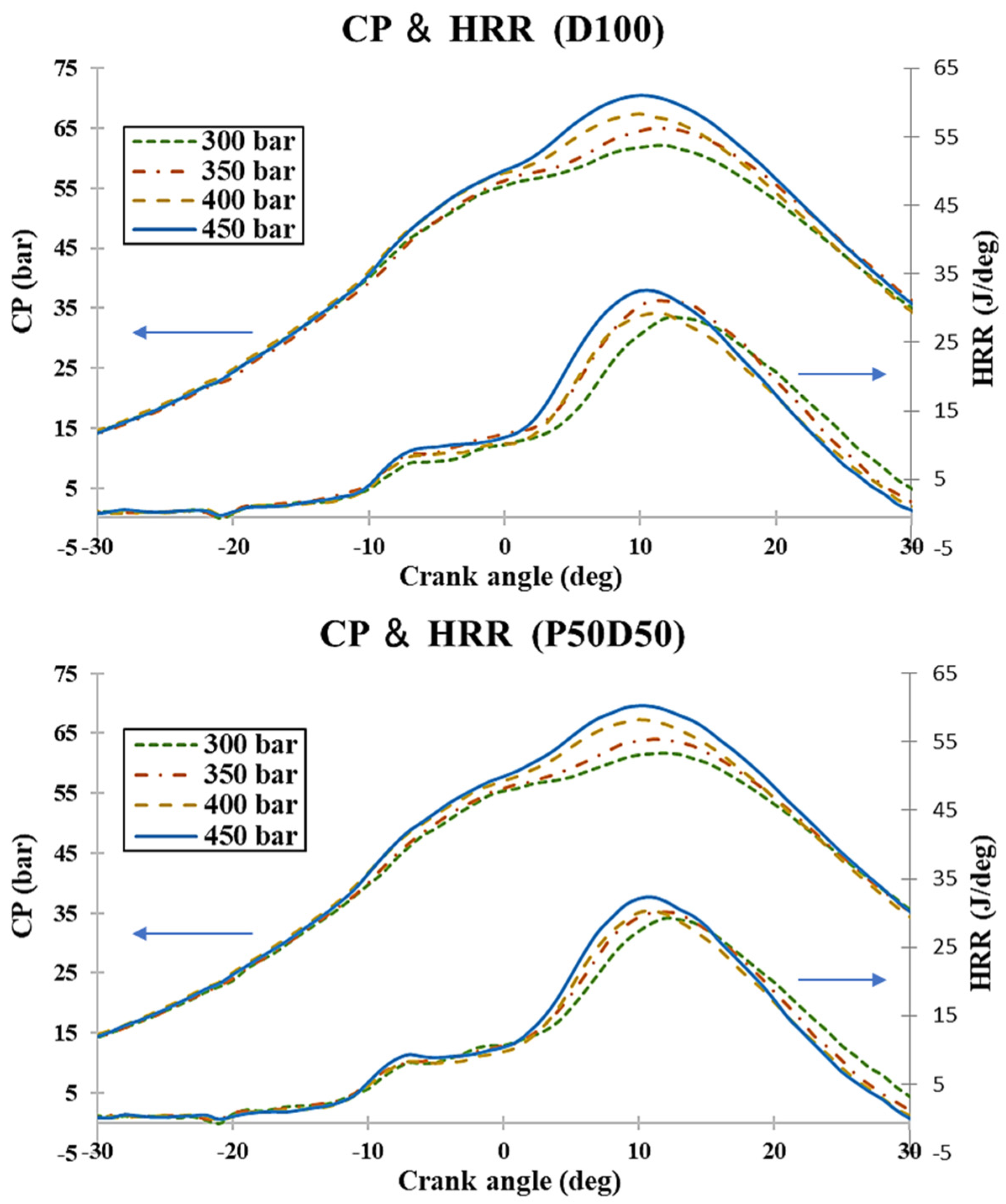
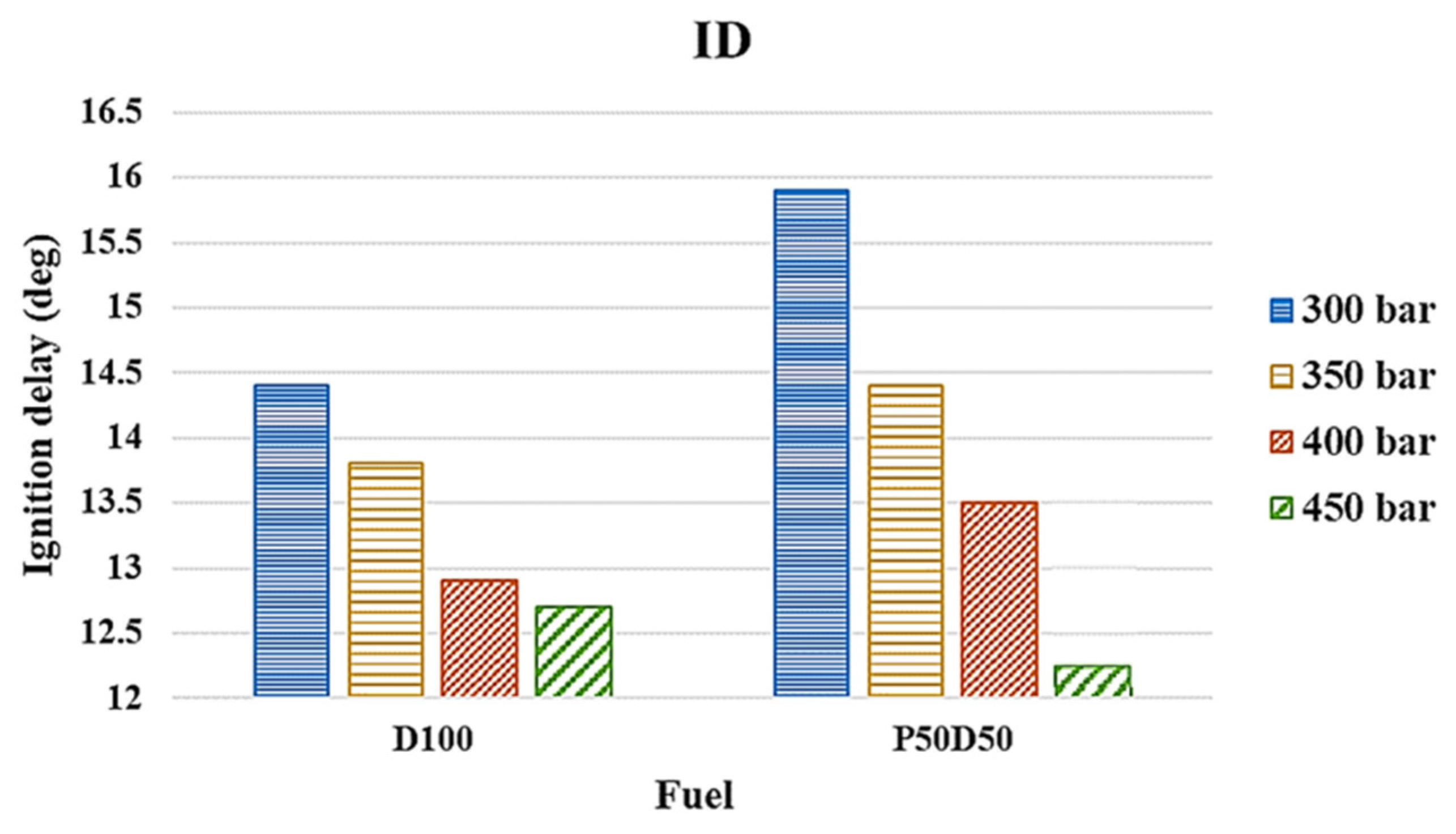
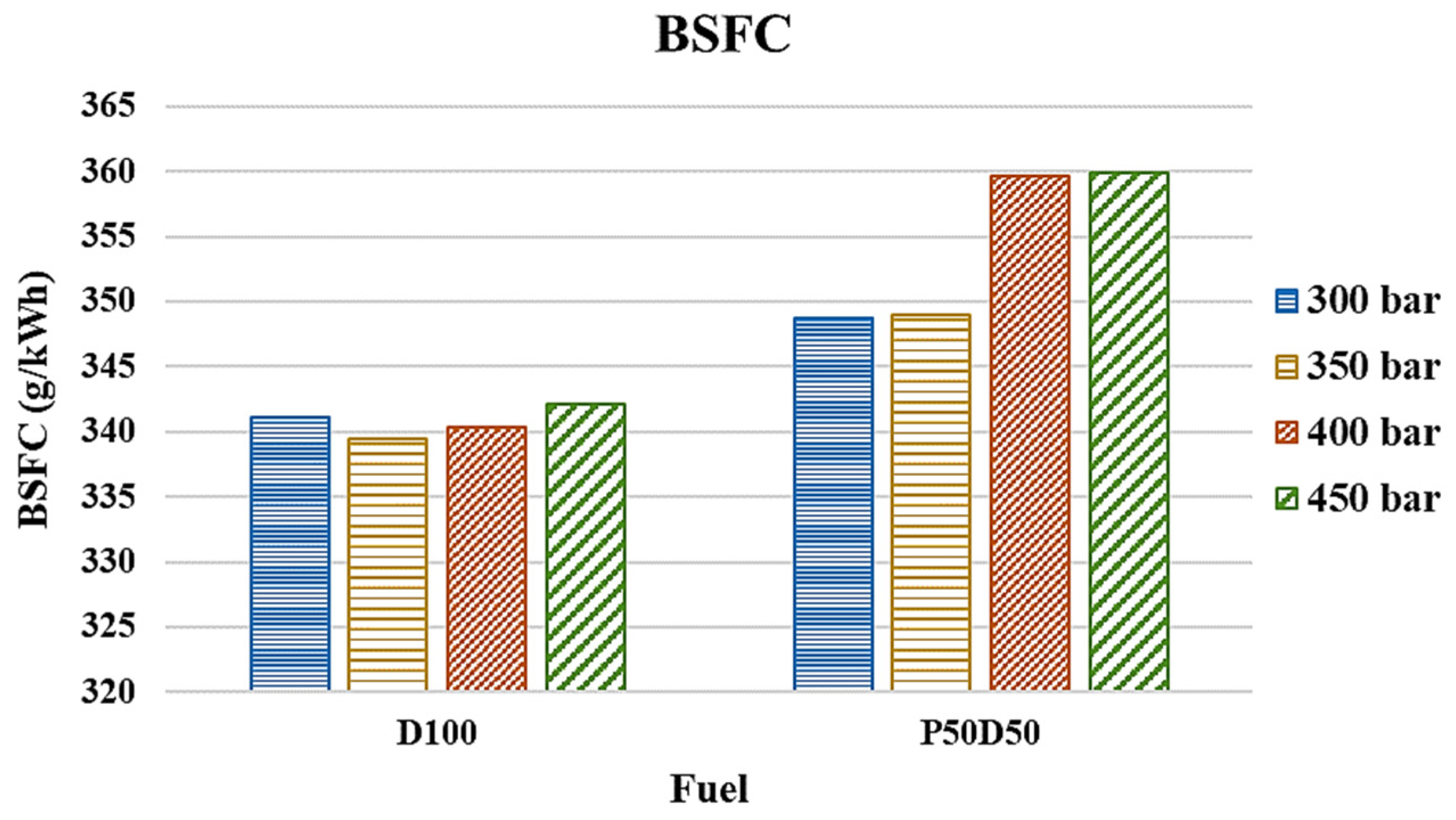






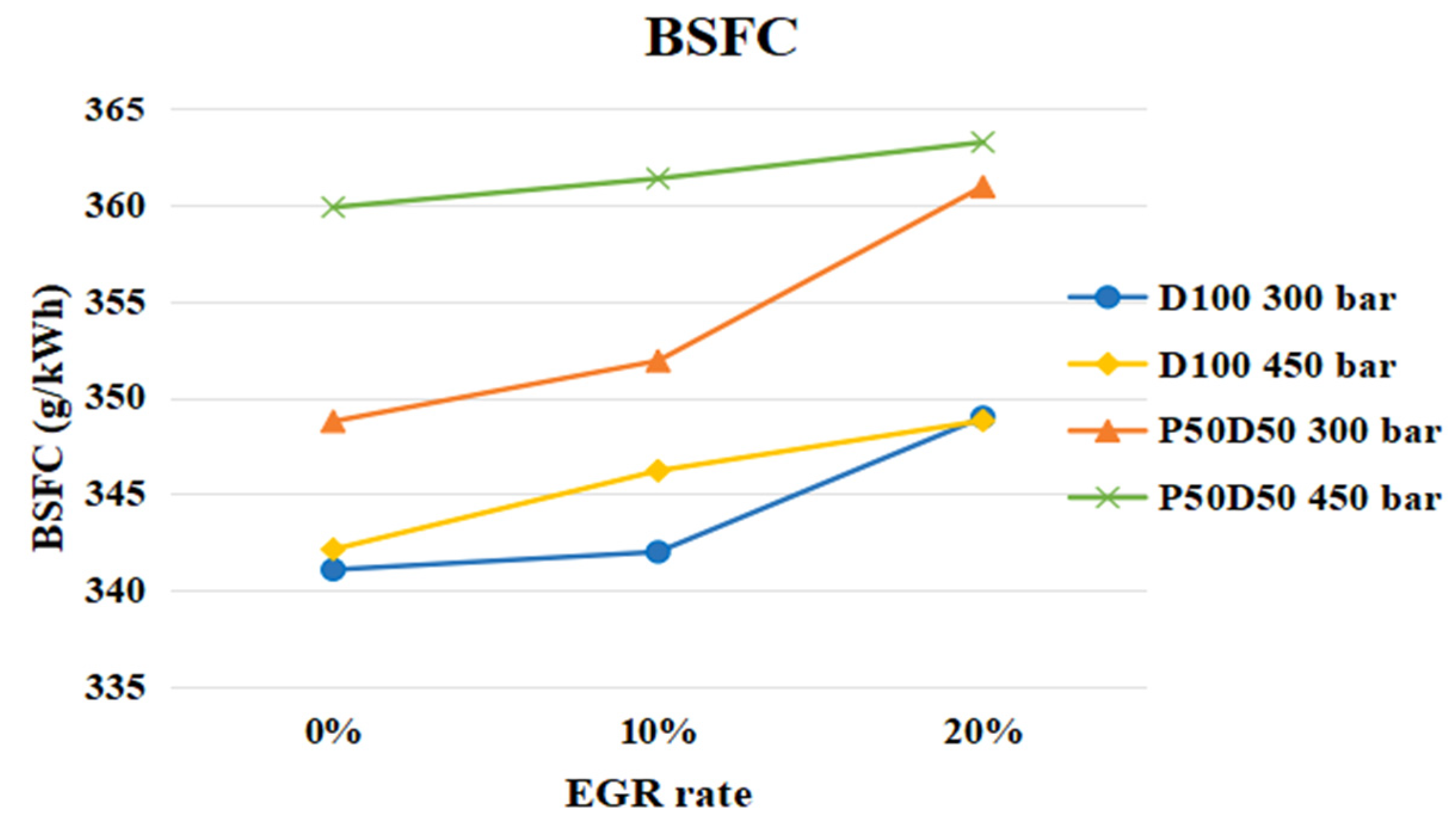

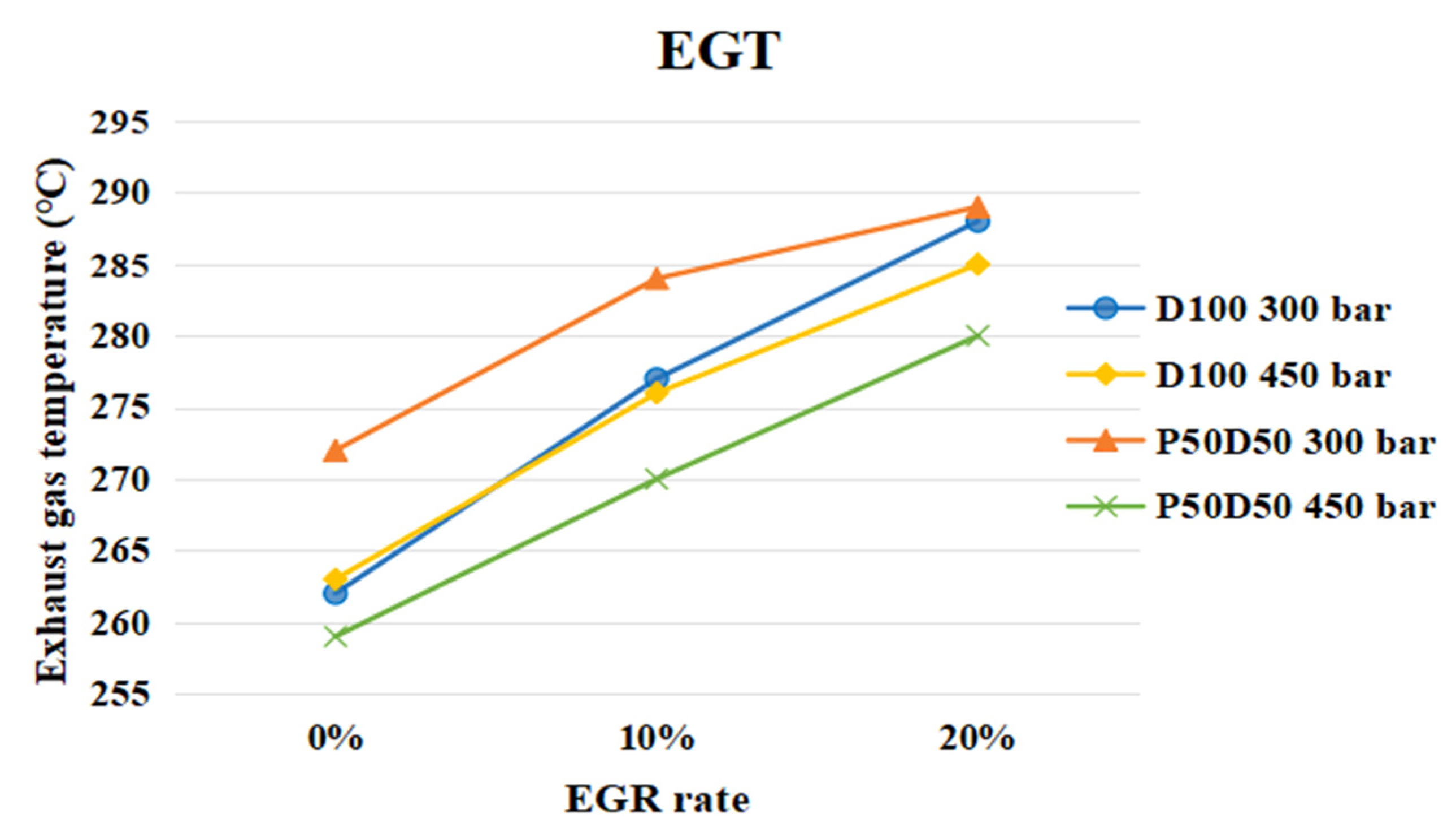


| Properties (Units) | Crude Palm Oil | Diesel |
|---|---|---|
| Density (kg/m3 at 15 °C) | 903.8 | 836.8 |
| Calorific value (MJ/kg) | 39.34 | 43.96 |
| Viscosity (mm2/s at 40 °C) | 42.21 | 2.719 |
| Cetane index | 49 | 55.8 |
| Flash point (°C) | 260 | 55 |
| Oxygen content (%) | 11.4 | 0 |
| Parameter (Units) | Specification |
|---|---|
| Engine type | In-line Four-cylinder |
| Air intake system | Turbocharger with WGT |
| Bore × stroke (mm) | 83 × 92 |
| Displacement (cc) | 1991 |
| Compression ratio | 17.7/1 |
| Maximum power (kW/rpm) | 82/4000 |
| Fuel injection system | Bosch common-rail direct injection |
| Number of injector nozzle holes | 5 |
| Injector spray angle (degree) | 150 |
| Injector hole diameter (mm) | 0.17 |
| Item (Unit) | Conditions | |
|---|---|---|
| Test fuels | D100, P50D50 | |
| EGR rate (%) | without EGR | 0, 10, 20 |
| Injection pressure (bar) | 300, 350, 400, 450 | 300, 450 |
| Speed (rpm) | 1600 | |
| Load (Nm) | 40 | |
| Pilot injection timing (°CA BTDC) | 21 | |
| Main injection timing (°CA BTDC) | 6 | |
| Intake air temperature (°C) | 25 ± 3 | |
| Cooling water temperature (°C) | 85 ± 3 | |
| Parameter (Units) | Accuracy |
|---|---|
| Fuel injection pressure (bar) | ±1 |
| Speed (rpm) | ±5 |
| Load (Nm) | ±0.2% |
| Intake air temperature (°C) | ±3 |
| Cooling water temperature (°C) | ±3 |
| Fuel consumption (g) | ±2 |
| NOx (ppm) | ±0.25% |
| Smoke opacity (%) | ±1% |
| Fuel | Injection Pressure (bar) | CPmax (bar) | CPmax Crank Angle (°CA) | HRRmax (J/deg) | HRRmax Crank Angle (°CA) |
|---|---|---|---|---|---|
| D100 | 300 | 62 | 12 | 28.57 | 12 |
| 350 | 65.1 | 11 | 31.00 | 11 | |
| 400 | 67.3 | 10 | 30.56 | 11 | |
| 450 | 70.4 | 10 | 33.16 | 10 | |
| P50D50 | 300 | 61.7 | 12 | 29.28 | 12 |
| 350 | 64 | 11 | 30.21 | 12 | |
| 400 | 67.3 | 10 | 30.39 | 11 | |
| 450 | 69.5 | 10 | 32.24 | 11 |
| Fuel | Injection Pressure (bar) | EGR Rate (%) | CPmax (bar) | CPmax Crank Angle (CA) | HRRmax (J/deg) | HRRmax Crank Angle (CA) |
|---|---|---|---|---|---|---|
| D100 | 300 | 0 | 62 | 11 | 28.58 | 12 |
| 10 | 60.1 | 11 | 27.98 | 12 | ||
| 20 | 58.8 | 11 | 27.41 | 12 | ||
| 450 | 0 | 70.4 | 10 | 32.47 | 10 | |
| 10 | 67.1 | 10 | 30.86 | 10 | ||
| 20 | 66.3 | 11 | 32.12 | 10 | ||
| P50D50 | 300 | 0 | 61.7 | 12 | 29.28 | 12 |
| 10 | 60.2 | 12 | 28.25 | 13 | ||
| 20 | 59 | 12 | 27.49 | 13 | ||
| 450 | 0 | 69.5 | 10 | 32.24 | 11 | |
| 10 | 67.6 | 11 | 32.66 | 11 | ||
| 20 | 66.7 | 10 | 31.09 | 11 |
Publisher’s Note: MDPI stays neutral with regard to jurisdictional claims in published maps and institutional affiliations. |
© 2022 by the authors. Licensee MDPI, Basel, Switzerland. This article is an open access article distributed under the terms and conditions of the Creative Commons Attribution (CC BY) license (https://creativecommons.org/licenses/by/4.0/).
Share and Cite
Wu, G.; Ge, J.C.; Kim, M.S.; Choi, N.J. NOx–Smoke Trade-off Characteristics in a Palm Oil-Fueled CRDI Diesel Engine under Various Injection Pressures and EGR Rates. Appl. Sci. 2022, 12, 1069. https://doi.org/10.3390/app12031069
Wu G, Ge JC, Kim MS, Choi NJ. NOx–Smoke Trade-off Characteristics in a Palm Oil-Fueled CRDI Diesel Engine under Various Injection Pressures and EGR Rates. Applied Sciences. 2022; 12(3):1069. https://doi.org/10.3390/app12031069
Chicago/Turabian StyleWu, Guirong, Jun Cong Ge, Min Soo Kim, and Nag Jung Choi. 2022. "NOx–Smoke Trade-off Characteristics in a Palm Oil-Fueled CRDI Diesel Engine under Various Injection Pressures and EGR Rates" Applied Sciences 12, no. 3: 1069. https://doi.org/10.3390/app12031069






